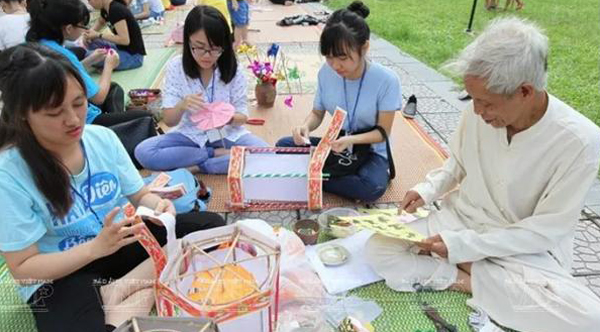


|
Quyen said that he learnt about the making ofkeo quanlanterns from his father when he was a little boy. Most of the children in his village in the past could make akeo quanlantern by themselves to play when the Mid-autumn festival came around. Nowadays, as society has developed and children are provided with a tonne of high-tech toys and online games, simple and traditional handicraft toys like akeo quanlanterns seem to attract less interest. Looking back on the 1990s,keo quanlanterns were one of the most exciting toys for children during the Mid-autumn festival, recalled a wistful Quyen. However, lanterns made in Dan Vien hamlet are less popular in today’s market. Thekeo quanlantern in Dan Vien hamlet often have a hexagon shape with its bottom having a rounded shape, they are all made with bamboo. Glossy glass paper is then glued onto the inside rectangles of the frame, and images of people, animals, and landscapes are stuck onto four or five layers on the outside cover of the lanterns to create vivid rotating characters. The lanterns can rotate thanks to an axle in the middle. When a candle is lit inside the lantern, a convection with a countercurrent of hot air inside the lantern and cool air outside is created to make it move. A small-sizedkeo quanlantern usually costs from VND 100,000 - 120,000 from a craftsman with around eight working hours. Quyen said that the making ofkeo quanlanterns helped children exercise patience, carefulness and creativity.
Artisan Nguyen Van Quyen (R) gives instructions to young people on how to make keo quan lantern at a programme hosted by the Vietnam Museum of Ethnology (Photo: Vietnam Pictorial) Over recent years, Quyen has been invited by the the Vietnam Museum of Ethnology Vietnam Exhibition Centre for Culture and Arts (VECCA) ahead of Mid-autumn festival to give instructions to visitors, particularly children, on how to makekeo quanlanterns. He has also received invitations from schools to help students play and make traditional toys. Quyen is currently working with the Vietnam Museum of Ethnology for the compilation of a book on Vietnamese folk games as a way to preserve his village’s traditional craft for younger generations. In recognition of his contributions, Quyen was recently nominated by the Hanoi City’s Culture and Sports Department to receive the title of ‘Meritorious Artist’. Quyen said that he hopes to pass down his understanding and knowledge of Vietnamese folklore culture for those who are interested, thus raising their awareness of safeguarding the country’s heritage. |